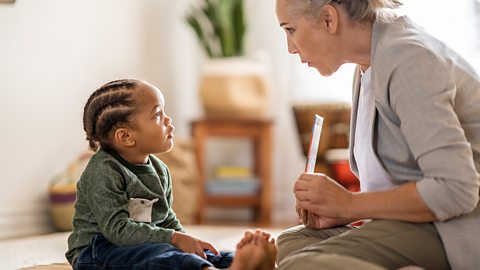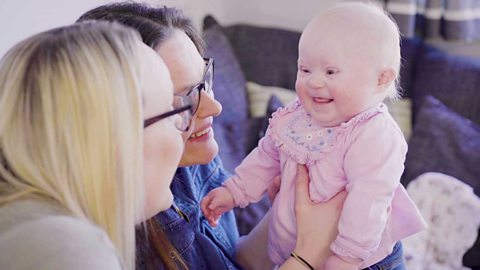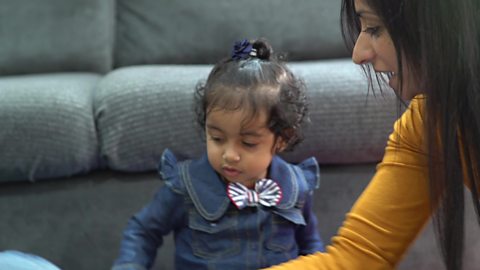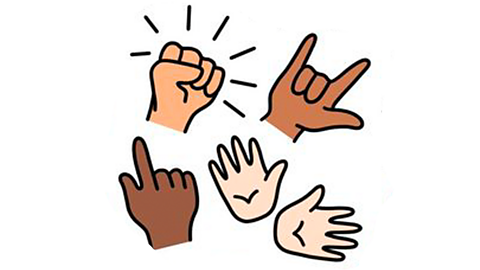
Ever wondered what baby signing is, the different types of signing you can do with your child and whether to try it out for yourself?
We caught up with the experts to find out everything you need to know about signing, including how to get started at home.
Speech and Language Therapist Laura Black says, ãBaby signing has become more popular in recent years. There are lots of reasons to sign with your baby. Parents can find they are more tuned in to their babyãs visual communication and feel like it helps create special bonds."
What is baby signing?
You might decide to use signing and symbols with your baby before they learn to talk, or if your child has communication difficulties, and many forms of signing can be used alongside spoken language. Signing with your baby or child will usually see you using different hand gestures,signs facial expressions, lip patterns and body language.
ãUsing signs alongside spoken language can help your child understand the meaning of different wordsã, says Laura. ãThey can link the word, sign and thing you are talking about together at the same time. It can reduce frustrations by giving them a way to communicate.ã
There are a number of different methods parents use in the UK to communicate with their children that you may have heard of. One of these is British Sign Language (BSL) which is a complete language in its own right. Other types of signing include Sign Supported English (SSE) Makaton and Signalong. ãWhichever method you choose to use, the most important thing to consider is consistencyã, adds Laura. ãIf you choose to use BSL signs for example, all of the adults your child interacts with should use the same signs.ã

Types of sign system
BSL (British Sign Language)
British Sign Language is a complete language with its own vocabulary and grammatical rules, which bear no relation to the spoken English language.
BSL is the language of the deaf community. Emma Fraser, Teacher of the Deaf at the National Deaf Childrenãs Society, says, ãIn Britain, there are over 70,000 people whose first or preferred language is BSL.ã
SSE (Sign Supported English)
This sign system uses speaking and BSL signs at the same time to communicate. SSE follows the same sentence structure as spoken English. Laura says, ãWhen signs are used for keywords in a phrase or sentence, this is known as Sign Supported English.ã
SSE is often used in schools to support deaf or hard of hearing children who are learning English grammar alongside their signing. Itãs also used amongst deaf people who use spoken language to support understanding.

Makaton
If you watch Something Special on CBeebies, youãll have already seen Makaton in action. Itãs a communication system that uses illustrated symbols and simple hand signs on top of everyday speech. These signs and gestures give your baby or child extra visual clues about what is being said. For example, the Makaton sign for ãbookã looks like a book opening.
Makaton is normally used with babies who arenãt yet able to speak words, and with children with additional needs or communication difficulties. Although some people use Makaton throughout their lives, lots of children use Makaton until they learn what words mean and no longer need to use the signs and symbols.
Signalong
Signalong uses BSL signs, but in the same order as youãd talk to your child. This form of signing also uses speech, body language, facial expression and tone of your voice to help link a sign to a specific word.
Much like Matakon, Signalong is often used to help people with communication difficulties. Itãs also a popular signing method used by parents who want to communicate with their baby before they can speak words.

When can you start signing with your baby?
ãBabies are never too young to learn to sign,ã says Emma. ãLearning about any language starts from the moment babies are born and the more language they hear and see, whether spoken, signed or both, the more likely they are to acquire it. Learning a signed language is no different from learning a spoken language. Many babies are able to make signs before they are able to speak, as hand-eye coordination develops earlier than speech ability.ã
Laura agrees and adds, ãMany parents start signing at around 6-8 months when babies are more aware of their surroundings and tuning into the world around them. Little ones may start signing back between 9-14 months whereas they may not have the skills to produce first words until around 12-15 months. Itãs also never too late to start signing with your baby or toddler!ã
Can baby signing delay children's speech?
ãThis is a myth and there is no evidence that signing delays childrenãs speech when used alongside spoken languageã, says Laura. ãWe are using signs alongside speech, not instead of it. Lots of parents find that signing ãbridges the gapã between understanding and speaking.ã
Emma adds, ãSigning can help families think about how they interact. Babies learn language when they can see it as well as hear it, so signs can help with understanding just as facial expressions and lip patterns do.ã
Top tips for signing with your baby or child

1. Say while you sign
If your child is using spoken language, then always ãsay while you signã. ãWe arenãt replacing spoken language with signs, so itãs important to continue to say words while we sign themã, says Laura. ãThis helps children link the sign to the spoken word and understand what it meansã.
2. Face your child
Youãll be using your face and hands to communicate, so make sure your little one is facing you so they can see how you do each sign. This will help them learn it too.
3. Sign about things your child is interested in
Look at whatever has caught your childãs attention and then sign that word. ãIf your child looks towards, or points to a cat, then sign ãcatãã, says Emma. And she also recommends doing a ãsign sandwichã, signing and naming an object - ãIf your child is also learning spoken English, attach the sign to the object and then also give the name in spoken language.ã This will reinforce the meaning of the sign.

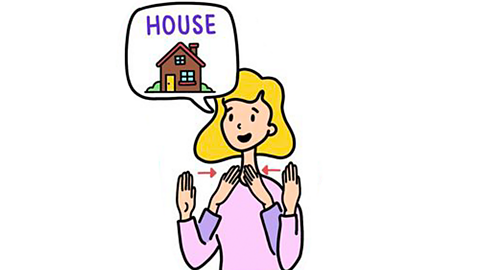
4. Chose a few signs to focus on at a time
You donãt want to overwhelm your little one, so Laura recommends sticking to a few signs at a time. ãUse them as much as you can and in as many different contexts as you can. That means in different places and with different people. The more frequently we model the signs to our little one, the quicker they will understand what they mean.ã
5. Keep it fun
Children learn through play. Making signing a fun activity means theyãre more likely to stay focused and want to learn. ãChildren in their early years learn to talk and sign by being in a rich language environment, not through sitting down with flash cards. Play and games are a great vehicle to introduce new signs. Books, songs and rhymes can help you introduce vocabularyã, says Emma.
6. Give your child the chance to practise
Thereãs a lot for your child to learn, so using signs that you use a lot like ãdrinkã, ãsnackã, ãmoreã and ãyesã will give them lots of chances to practise.
7. Take your time
Your child may not sign words perfectly to begin with because they are still developing their motor skills, explains Laura. However, itãs important to encourage them, ãRespond to them as soon as they have signed to you, so they know they have been successful. They may also make up their own signs and thatãs great! Use the signs they prefer as these will be more meaningful to them. This involves watching and waiting sometimes - donãt be in a rush to do all the talking - give your child a chance to respond.ã
8. Help your child ãfeelã the signs
Signing sees your hands move into all sorts of shapes. Help your child get to grips with this by gently moving their hands into the different signs. By feeling the movement themselves, this will help them learn the signs.
As links to external organisations aren't run or maintained by the ôÕÑ¿å¥éá we can't guarantee their content ã nor are we endorsing them as a product.


